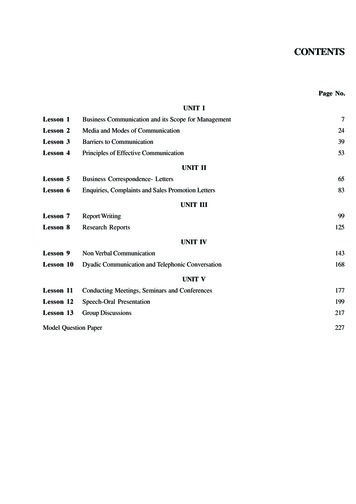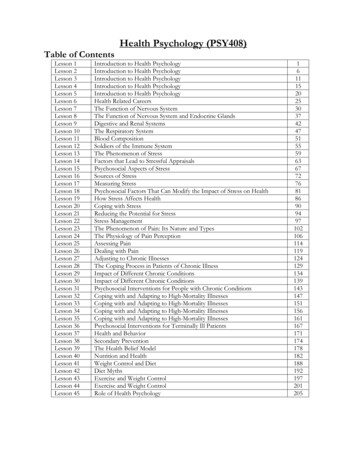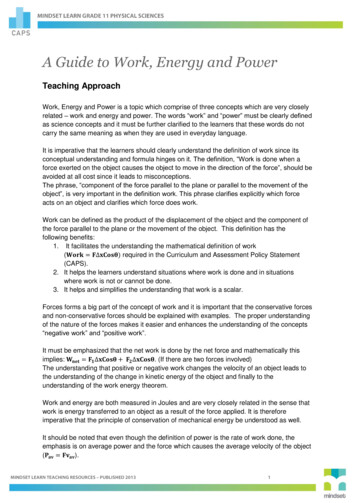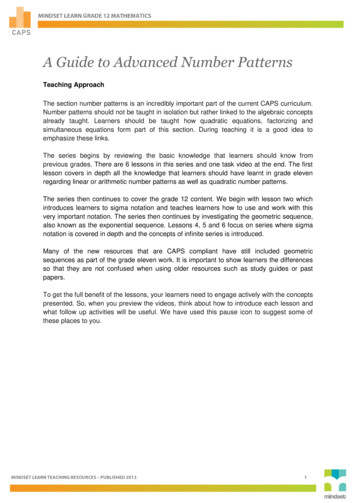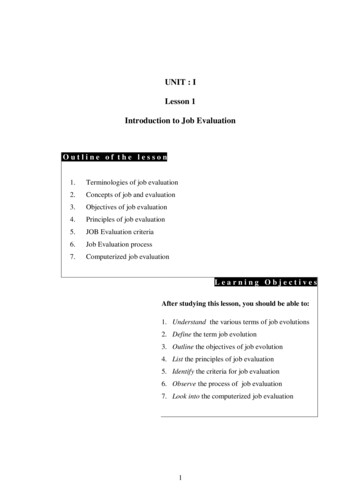
Transcription
UNIT : ILesson 1Introduction to Job EvaluationOutline of the lesson1.Terminologies of job evaluation2.Concepts of job and evaluation3.Objectives of job evaluation4.Principles of job evaluation5.JOB Evaluation criteria6.Job Evaluation process7.Computerized job evaluationLearning ObjectivesAfter studying this lesson, you should be able to:1. Understand the various terms of job evolutions2. Define the term job evolution3. Outline the objectives of job evolution4. List the principles of job evaluation5. Identify the criteria for job evaluation6. Observe the process of job evaluation7. Look into the computerized job evaluation1
IntroductionOnce a right candidate is placed on a right job, the person needs to be dulycompensated for the job he/she performs. In the pursuit of equal payment, thereshould be established a consistent and systematic relationship among basecompensation rates for all the jobs within the organizations. The process of suchestablishment is termed „job evaluation‟. Different jobs in an organization needto be valued to ascertain their relative worth so that jobs are compensatedaccordingly and an equitable wage and salary structure is designed in theorganization. This is necessary for sustaining cordial relations within andbetween employees and employer. Hence, there is a need for appreciation ofintricacies of the job evaluation in the modern organizations. This lesson, as afirst steps, dedicated to discuss the various fundamental aspects of jobevolution.Concept and related terminologies of job evaluationIn the area of job evaluation study, a certain amount of technical terminology isused in order to facilitate communication. It is therefore desirable to list andunderstand allied terms in the job evaluation, as well as some terms that arerelated to and often confused with job evaluation (Exhibit. 1.1).Position: A position is a group of tasks assigned to one individual. There are asmany positions in a firm as there are personnel.Job: Edwin B.Flippo describes job as a group of positions that are similar as tokind and level of work. In some instances only one position may be involved,simply because no other similar position exists. For example, in the typical firmthe position of human resource manager also constitute a job since there is onlyone human resource manager in the organizing.2
Job Analysis: It is the process of studying and collecting information relating tothe operations and responsibilities of a specific job. The immediate products ofthis analysis are job descriptions and job specifications.Motion study: This also involves study of the job. Motions study is one of theways of studying job. It is a process of analyzing a job to find the easiest, mosteffective, and most economical method of doing it. As such, motion study is apart of the job design function.Job description: It is an organized, factual statement of the duties andresponsibilities of a specific job. In brief, it should tell what is to be done, how itis to be done, and why. It is a standard of function, in that it defines theappropriate and authorized content of a job.Job specification: It is a statement of the minimum acceptable human qualitiesnecessary to perform a job properly. It is a standard of personnel and designatesthe qualities required for acceptable performance.Evaluation: Wigley explains evaluation as a data reduction process thatinvolves the collection of large amounts of data which are analyzed andsynthesized into an overall judgment of worth or merit. The implication here isthat the judgment of worth can be supported by the data. In her review, Foxonfound similar definitions referring to judgments of value or worth.Job Evaluation: It is a systematic and orderly process of determining the worthof a job in relation to other jobs. The objective of this process is to determinethe correct rate of pay. It is therefore not the same as job analysis. Rather itfollows the job analysis process, which provides the basic data to be evaluated.3
Exhibit. 1.1Job evaluationMeasuringrelative worth of ajobJob specificationStatement ofminimum acceptableHuman qualitiesJobJob AnalysisProcess ofcollecting jobrelated dataJob descriptionStatement of a jobduties andresponsibilitiesIn simple worlds, job evaluation is the rating of jobs in an organization. This isthe process establishing the value or worth of jobs in a job hierarchy andcompares the relative intrinsic value or worth of jobs within an organization.Some renounced definitions of job evaluation are described below.Scott, Clothier and Priegel defines job evaluation as “the operation ofevaluating a particular job in relation to other jobs either within or outside theorganization”.Dale Yoder described job evaluation as “a practice which seeks to provide adegree of objectivity in measuring the comparative value of jobs within anorganization and among similar organizations”.Edwin B.Flippo defines job evaluation as “a systematic and orderly process ofdetermining the worth of a job in relation to other jobs”.4
Arthur A. Sloane described job evaluation as “any formalized system thatattempts to determine the relative worth of different jobs in the organization sothat jobs of greater value can be rewarded by greater pay”.According to the International Labour Organization (ILO), “job evaluation isan attempt to determine and compare the demands which the normalperformance of a particular job makes on normal workers, without taking intoaccount the individual abilities or performance of the workers concerned”.The British Institute of Management defines “job evaluation as the process ofanalysis and assessment of jobs to ascertain reliably their negative worth usingthe assessment as the basis for a balanced wages structure”.Wendell French defines job evaluation as “a process of determining the relativeworth of the various jobs within the organization, so that differential wages maybe paid to jobs of different worth. The relative worth of a job means relativevalue produced. The variables which are assumed to be related to valueproduced are such factors as responsibility, skill, effort and workingconditions”.Objectives of job evaluationThe main objective of job evaluation is to ensure equitable remuneration forrelative worth of a job. As per the ILO Report, the aim of the majority ofsystems of job evaluation is to establish, on agreed logical basis, the relativevalues of different jobs in a given plant or machinery, i.e., it aims at determiningthe relative worth of a job. The principle upon which all job evaluation schemesare based is that of describing and assessing the value of all jobs in the firms in5
terms of a number of factors, the relative importance of which varies from job tojob”.The objectives of job evaluation, to put in a more systematic manner are to:1. Establish a standard procedure for determining the relative worth ofeach job in an organization;2. Ensure equitable wage for a job and reasonable wage differentialsbetween different jobs in a hierarchical organization;3. Determine the rate of pay for each job which is fair and equitable withrelation to other jobs in the plant, community or industry;4. Eliminate wage inequalities;5. Use as a basis for fixing incentives and different bonus plans;6. Promote a fair and accurate consideration of all employees foradvancement and transfer;7. Provide information for work organization, employees‟ selection,placement, training and other similar purposes;8. Provide a benchmark for making career planning for the employees inthe organization and;9. Ensure that like wages are paid to all qualified employees for likework.Principles of job evaluationThe job evaluation has certain principles. These principles are supposed to bekept in the mind of the job evaluators. These principles are not only directivesof proper job evaluation but also provide clarity in the process of evaluation.According to Kress, these principles are:1. Rate the job and the jobber. Each element should be rated on the basis ofwhat the job itself requires;6
2. The elements selected for rating purposes should be easily explainable interms and a few in numbers as will cover the necessary requisites forevery job without any overlapping;3. The elements should be clearly defined and properly selected;4. Any job rating plan must be sold to foremen and employees. The successin selling it will depend on a clear-cut explanation and illustration of theplan;5. Foreman should participate in the rating of jobs in their owndepartments;6. Maxim mum co-operation can be obtained from employees when theythemselves have an opportunity to discuss job ratings and;7. Too many occupational wages should not be established. It would beunwise to adopt an occupational wage for each total of point values.Job Evaluation CriteriaThe system of job evaluation utilises a total of eight measurement factors.The various factors analyse a position in relation to the skills andexperience required for competent performance, the demands made on thejob and the overall structure and responsibility/accountability involved.Apoint rating is derived for each factor and the sum of these points representsthe total point‟s value of the job.Basic Evaluation Rules: The basic rules for evaluating each position are:1. The current position is evaluated without being influenced by what thejob is likely to be in the future or what it may have been in the past.2. The position is evaluated and not the job holder.The assessmentof each factor is based on the job being performed competently. Theassessment of the job holder‟s own performance against the standard7
required is a quite separate exercise which is outside the scope of thejob evaluation rating.The Job Evaluation Factors: The job evaluation system comprises the followingfactors: In some cases minor changes to the wording are used to definefactors and levels made in order to better align the methodology withthe client‟s culture and environment.Where this is done, great care istaken to ensure inter-organisation consistency is not compromised. Theprimary factor in determining compensation is an evaluation of work performed.The internal worth of a job is evaluated based upon factor like - Know-How,Problem Solving, and Accountability, Education, Experience, Complexityinvolved in the job, Scope of job, Supervision received and, AuthorityExercised.1. Know-How – The knowledge, skill and experience required forstandard acceptableperformance. It considers the requirement fortechnical and professional skills, expertise and experience, the amountof planning and organising required and the requirement to work withand through others. The three dimensions of Know-How are listed belowexhibit.1.2.Exhibit.1.2TechnicalMeasures levels ranging from learning basics work toKnow-Howspecialized techniques and knowledge to professionalmastery of scientific theory.ManagerialMeasures the job‟s requirements to integrate diversifiedKnow- Howtypes of supervisory or managerial activities.HumanMeasures the degree to which the job requires practicalrelationperson to-person skills in persuasion, motivation, andKnow-howselection of people.8
2. Problem Solving – the thinking required for analysing, evaluating,creating, reasoning, arriving at and drawing conclusions; the extentto which this thinking is covered by precedents or circumscribed bystandards; and the degree of creativity or original thought required. Thetwo dimension of problem solving are presented below.Exhibit.1.3ThinkingThe degree of structure provided by the job in solvingenvironment problems.ThinkingIt is the complexity of the problems in the job assignmentChallengeand the amount of thinking required to solve job-relatedproblem.3. Accountability – The degree to which the employee is held accountable fortaking action and for the consequences of that action. It is the measuredeffect of the job on end results. The freedom to act measured through theexistence or absence of constraints by managers, committees andprocedures and the impact of that action on the organization. The threedimensions of accountability are depicted in below exhibit.Exhibit.1.4Freedom to actMeasures the relative degree to which decisions canbe made, the level of authority which is needed, orthe precedents, policies, and procedures which mustbe considered before an employee can take action.MagnitudeIt is the degree of influence a position has on theorganizational operations.ImpactIt is the degree to which the job affects theorganizational operations. Some jobs are directlyresponsible for actions while others provide counseland advice, which is used by others to take action.9
4. Education - The level of formal education required to perform thefunctions required of a position. There is often an overlap betweeneducation and experience, and for this reason it is often advisable toconsider the education level that would be expected of a new incumbentrecruited externally.5. Experience - The length of practical experience and nature oftechnical/managerial familiarity required. This experience is in additionto formal education.6. Complexity – measured in terms of: (a) the time taken to learn and adjustto specific job requirements, (b) the level to which the job functions aredefined and follow established and predictable patterns and, (c) ngcircumstances and innovative or conceptual thinking needed to initiatenew corporate direction.7. Scope of Job - The complexity and scope of work factors tend to berelated to the education and experience level required of a position. Thecalculation of points for each of these factors is based on the applicationof a percentage rating of the sum of the points derived in the evaluationof Education and Experience.8. Supervision Received -The extent of supervision, direction or guidanceimposed on the job holder and the freedom the executive has to takeaction.9. Authority Exercised - Authority level expressed in terms of routineexpenditure, capital expenditure and investments, granting of loans,hiring and firing staff, etc.10
Job Evaluation ProcessJob Evaluation is a technique to rank jobs in an organization on the basis ofthe duties and responsibilities assigned to the job. The job evaluation processresults in a job being assigned to a pay grade. The pay grade is associated witha pay range that is defined by a minimum and a maximum pay rate. A model ofjob evaluation process with the following steps is presented bellow (Exhibit1.5).Step One -Job Description - The position supervisor assigns duties and writes thejob description. If there is an incumbent employee, s/he reviews it, and theyboth sign it.Instructions and additional assistance are available fromHuman Resources, if needed. The job description is a snapshot of the job asit presently exists, reflecting the current duties and responsibilities of the joband/or the incumbent.Step Two – Approval - The vice president reviews job descriptions and, if s/heconcurs, approves the responsibilities, requirements, and depart-mentalorganization contained within a job description presented for new evaluation,and signs it.If the vice president does not concur with the contents of thedescription, it is returned to the supervisor for changes.Step Three – Review- Human Resources reviews the job description assubmitted with the supervisor prior to evaluation by the Job Evaluatio nCommittee (Step 4).Human Resources help ensure that there is consistencyand equity in the job descriptions and titles by editing them for clarity andformat. If the Human Resources Office makes changes, the job description isreturned to the supervisor and vice president for signature prior to beingpresented to the Job Evaluation Committee (Step 4).11
Step Four – Evaluation - The Job Evaluation Committee (JEC) is a multimember committee, the members of which are appointed by the Staff SalaryAdministration Committee (SSAC), representing employees throughoutorganization. JEC ensures equity among jobs through the use of established,consistent criteria for evaluation and prevents escalation of the jobevaluation grades by validating changes in job content presented for review.Members of JEC receive in-depth training on job evaluation and utilize aconsistently applied point system for the evaluations.Step Five – Confirmation - SSAC confirms all job evaluations and titlesrecommended by JEC.This committee is com-posed of the SLCC VicePresidents, the human resources director, and other relevant co-opted experts.After confirmation of the evaluation job description, SSAC advises thesupervisor of the results of the evaluation and the title.advises the employee of the results of the job evaluation.12The supervisor then
Exhibit 1.513
Computerized job evaluationMuch of the time-consuming effort spent on maintaining a job evaluationprogramme can be reduced by combining personal computers with jobevaluation software. Computer-aided system simplifies the administration of jobevaluation programmes and provides a more expedient means of processing jobevaluation information. Job data can be collected from supervisors by using astructured, machine-scoreable questionnaire. Computer software can be used toanalyze the questionnaire responses and perform the job evaluation. With theadvent of skill-based pay, which focuses on an employee‟s education,experience, and skills developed in programmes, a computer programme canupdate employee knowledge and skills as they are acquired. Pay adjustments arethen made to reflect the employee‟s increased knowledge and skills.SummaryAfter reading the first lesson, some of the important points regarding jobevaluation would be remembered. First, as the name implies, job evaluation isan attempt to assess and evaluate a specific job or category of jobs, not theperson holding the job. The assessment of the job reflects the worth of a job inthe hierarchical jobs of organization. Based on the worth of each job,compensation is decided to each and every job without any imbalance inmonitory terms. The latter issue is the function of performance appraisal ratherthan job evaluation.The summary is organized by the learning objectives expressed in the beginningof the lesson.1. Job evaluation is a technique used to determine the value of each job inrelation to all jobs within the organization. Its main objective is to14
determine the relative worth of different jobs in an organization to serveas a basis for developing rational wages and salary structure.2. Evaluating job not jobber is the major principle job evaluation.3. The criteria for job evaluation is consideration of various factors,which analyse a position in relation to the skills and experiencerequired for competent performance, the demands made on the joband the overall structure and responsibility/accountability involved.4. Job Evaluation is a technique to rank jobs in an organization on thebasis of the duties and responsibilities assigned to the job. The jobevaluation process results in a job being assigned to a pay grade.Key termsJobEvaluat ionJob evaluationJob analysisJob descript ionJob specificat ionJob gradingJob classificationBenchmark JobDiscussion questions1. What is job evaluat ion?2. What are the objectives of job evaluat ion3. Narrate very briefly the distinguishing features of job analysis,job description, job specificat ion and job evaluat ion.4. What are the principles of job evaluat ion?5. Discussion the process of job evaluation.6. „Job evaluation is the ranking of job not the job holder‟.Comment.7. Discuss the advantages of job evaluat ion.15
References:Arthur A. Sloane, Personnel - Managing human resources, Prentice-Hall Inc.,Engledwood Cliffs, New Jersey, 1983, p.266.British Institute of Management: Job Evaluation – A practical Guide, London,1951, p.77David A. Decenzo and Stephen P. Robbins, Personnel/Human ResourceManagement, Printice-Hall of India Private Limited, New Delhi, 1996,p.428.Edwin B. Flippo, Personnel Management, Tata McGraw-Hill PublishingCompany Limited, New Delhi, 1980, p. 258.Foxon, M. (1989). Evaluation of training and development programs: A reviewof the literature. Australian Journal of Educational Technology. 5(1), 89104.International Labour Organization (ILO), Job evaluation – Studies and Reports,New Series, No.56, Geneva, 1960,p.8.Michel Armstrong, A Handbook of Human Resource Management, AdityaBooks Private Limited, New Delhi, 1990. p. 99.Wigley, J. (1988). Evaluating training: Critical issues. Training andDevelopment in Australia, 15(3), 21-24.www.jamombud.se16
UNIT : ILesson 2Job Evaluation MethodOutline of the lesson1. Ranking Method2. Job Classification Method3. Point Rating Method4. Factors Comparison Method5. Advantages of Job Evaluation6. Limitations of Job EvolutionLearning ObjectivesAfter studying this lesson, you should be able to:1. Identify application of ranking method2. Understand the process of job classification3. Locate the relevance of point rating method4. Understand factors comparison5. Know the advantages of job evaluation6. Underline the limitations of job evaluation17
IntroductionAs we understood in the lesson 1, the job evaluation is aimed at determining therelative worth of a job. It involves a formal and systematic comparison of jobsin order to determine the worth of one job relative to another and eventuallyresults in a wage or salary hierarchy. The basic process also viewed as anactivity of comparing the comparing the content of jobs in relation to other interms efforts required, responsibility involved and skills needed. The entireprocess is planed and prepared systematically by a job evaluation committee.A number of job evaluation methods have been developed since the 1920‟s, andmany, if not most, of them are still used. They all have the same final objective– ranking jobs in terms of their relative worth to the organization so that anequitable rate of pay can be determined for each job. As the job evaluation ismostly a judgemental process that would probably use one of the job evaluationmethods, which are commonly grouped into two major categories: quantitativeand non-quantitative. The basic difference between these two methods lies inthe sense that, under non-quantitative methods, a job is compared as a wholewith other jobs in the organization, whereas in case of quantitative methods, thekey factors of a job are selected and, then measured. The most commonly usednon-quantitative methods are ranking and job classification or grading method,while the most common quantitative methods are factor comparison and pointrating. The starting point for all job evaluation methods is a current jobdescription and job specifications.Non-quantitative methodsNon-quantitative methods call for the evaluation of a whole job relative totother jobs or to general descriptions of jobs within an organization. Forinstance, a job description of a customer service representative may be18
compared to the job description of a word processing specialist. The main roleof the evaluator is to determine which of the jobs is more important or worthmore to the organization. The major types of non-quantitative job evaluationprocedures are ranking and job classification.Ranking Method of job evaluation – This is simplest form of job evaluationmethod. The method involves ranking each job relative to all other jobs, usuallybased on some overall factor like „job difficulty‟. Each job as a whole iscompared with other and this comparison of jobs goes on until all the jobs havebeen evaluated and ranked. All jobs are ranked in the order of their importancefrom the simplest to the hardest or from the highest the lowest. The importanceof order of job is judged in terms of duties, responsibilities sand demands on thejob holder. The following steps are involved in ranking jobs.1. Obtain job information - The first step is job analysis. Job descriptionsfor each job are prepared and these are the basis on which the ranking sare made. The job ranking method usually ranks jobs according to „thewhole job‟ rather than a number of compensable factors.2. Select raters and jobs to be rated - Ranking all the jobs, at a time, isusually not possible. The more usual procedure involves ranking jobs bydepartment or in „clusters‟ i.e. factory workers, clerical workers and soon. This eliminates the need for having to compare directly, say, factoryjobs and clerical jobs.3. Select Compensable factors – In the ranking method, it is common touse just one factor, for instance job difficulty, and to rank jobs on thebasis of „the whole job‟. Regardless of the number of factors youchoose, it is advisable to carefully explain the definition of the factor(s)to the evaluators so that they evaluate the jobs consistently.19
4. Rank jobs - Next, the jobs are ranked. The simplest way to do thisinvolves giving each rater a set of index cards, each of which contains abrief descript of a job. These cards are then ranked from lowest tohighest.5. Combine Rating - It is usually to have several raters rank the jobsindependently. Finally, divide all the ranked jobs into appropriate groupsor classifications by considering the common features of jobs such assimilar duties, skills, or knowledge required. All the jobs within aparticular group or classification receive the same wage or range ofraters. Then, once this is accomplished, the rating committee can simplyaverage the ranking.The ranking of jobs in an Academic Institution, based on Ranking Method,may be like this:Exhibit. 2.1 Ranking of Academic Institution JobsRanking orderPay ScaleProfessors / Registrar / LibrarianRs.16400 – Rs. 22,400Readers / Deputy Registrar / Deputy LibrarianRs. 12000 – 420 – 18,300Rs. Lecturer/Asst. Registrar /Asst. LibrarianRs. 8000 – 275 – 13,500Merits – Ranking method has the following merits in terms of its procedure,resources involvement and operatational mechanisms.1. It is the simplest method2. It is quite economical to put it into effect3. It is less time consuming and involves little paper work.Demerits – The ranking method has the following demerits in terms of validityand reliability.20
1. The main demerit of the ranking method is that there are no definitestandards of judgement and also there is no way of measuring thedifferences between jobs.2. It suffers from its sheer unmanageability when there are a large numberof jobs.Job Classification or Grading Method – This is a simple, widely usedmethod. This method of job evaluation was made popular by the U.S. CivilService Commission. In the ranking system there is no re-determinedyardstick of values. In the job grading approach there is one such yardstickconstituting of job classes or grades. Jobs are measured as whole jobs.Under this method job grades or classes are established by an authorisedbody or committee appointed for this purpose. A job grade is defined as agroup of different jobs of similar difficulty or requiring similar skills toperform them. Job grades are determined on the basis of information derivedfrom job analysis. The example of job grades may include, depending on thetype of jobs the organization offers, skilled, unskilled, account clerk, clerkcum typist, steno-typist, office superintendent, laboratory assistant and soon.There are several ways to categorize jobs. One is to draw up „classdescription‟ and place jobs into classes based on their correspondence tothese descriptions. Another is to draw up a set of classifying rules for eachclass and then categorise the jobs according to these rules. The usualprocedure is to choose compensable factors and then develop class or gradedescriptions that describe each class in terms of amount or levelcompensable factor(s) in jobs. Such factors are:1. Difficultly and variety of work,21of
2. Supervision received and exercised,3.Judgement exercised,4. Originality required,5. Nature and purpose of interpersonal work relationships,6. Responsibility,7. Experience and,8. Knowledge requiredThe following five steps are generally involved in the process of jobclassification.1. Prepare job description for basic information about he job2. Prepare job grading description for identification of different levels ofjobs. Each grade level must be distinct from the grade level adjacent toit. After establishing the grade level, each job is assigned to anappropriate grade level on the basis of the complexity of duties, nonsupervisory responsibilities and supervisory responsibilities3. Select grades and key jobs about 10 to 20 jobs, which include all themajor departments and functions and cover all the grades4. Grade the key jobs. Key jobs are assigned to an appropriate grade leveland their relationship to each other studied.5. Classify all the jobs on the basis of grade definitions. All the jobs in thesame grade receive the same wage or range of rate. For instance, menialsmay be put into one class; clerks in another; junior officers in a higherclass; and the tope executives in the top class.The exhibit 2.2. gives us the gradation of five classes clerks designed by atitle label and different values of each job on the basis of respective jobduties and responsibilities.22
Exhibit. 2.2 Description of job classificationGradesHead ClerkJob ClassificationThose handling or capable of taking a major decisionon the work they do; complicated work requiringmuch independent thinking; able to consider detailsoutside the control.Senior ClerkTechnically varied work, occasionally independentthinking and action due to difficult work whichrequire exceptional clerical ability and extensiveknowledge of principles and fundamentals of thebusiness of is department.Clerical Grade IIIPure routine concentration, speed and accuracy, worksunder supervision; may be held responsible forsupervisionClerical Grade IINo supervision by others, especially skilled for thejob by having an exhaustive knowledge of the details.C
Job Evaluation: It is a systematic and orderly process of determining the worth of a job in relation to other jobs. The objective of this process is to determine the correct rate of pay. It is therefore not the same as job analysis. Rather it follows the job analysi



